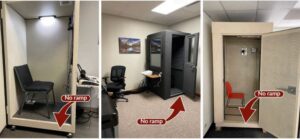
After 22 years in the Army, serving in Vietnam and as a logistics specialist worldwide, veteran Mark Maloney, shown here finishing a race, maintained an active lifestyle until he suffered a spinal cord injury from a bicycle accident. The Spinal Cord Injuries and Disorders Center at the Rocky Mountain Regional VAMC in Aurora, CO helped him be able to walk a kilometer with the assistance of the Lite Run device. Now, veteran advocates are warning that spinal center care at the VA is in crisis. VA photo
WASHINGTON, DC — The Spinal Cord Injury and Disorders (SCID) system, the hub-and-spoke model of care that VA uses to treat some of its most vulnerable veterans, is in danger of collapse, veterans’ advocates are telling lawmakers. According to them, the system is under-financed and understaffed, with patients being turned away because of the lack of resources.
VA has 25 SCID centers across the country, specially designed and staffed to meet the needs of veterans with spinal cord injuries and disorders. Each of those facilities is called a “hub.” They work with VA medical centers that do not have SCID centers, called “spoke” facilities. The goal is to ensure a comprehensive network of spinal cord care for veterans no matter where they live.
However, as of May, only 153 of the 181 long-term beds at the SCID centers are available. While some might be vacant due to disease mitigation measures, the main cause is likely staffing. According to VA, the SCID centers have a 9% vacancy rate—a decrease from previous years—and the department has increased SCID staffing by 230% in the past five years. However, hiring remains a challenge.
“This is a highly skilled area,” VA’s Chief Medical Officer Erica Scavella, MD, told the House VA Committee last month. “These veterans require lots of care, lots of patience. It takes a certain type of professional to be a provider of that care. Making sure we recruit and retain the highest skilled employees in that area is important.”
Despite these unavailable beds, she testified that veterans are never turned away from SCID facilities, a statement that was met with headshakes from many veterans and advocates in the audience.
She also said there was no waiting list for care.
“We will make sure we coordinate with our community partners or transfer patients to other facilities at VA,” she said.
This does not accurately describe the reality veterans with spinal cord issues face, advocates said.
“The SCI system is at a breaking point,” declare Carl Blake, CEO of the Paralyzed Veterans of America. “We survey all the SCI systems on an annual basis, and every month do a bedding/staffing survey. This is what we know to be true: There are nurse staffing shortages all over the system. It’s not 9%. It’s more like 30%. There’s a severe lack of resources dedicated to this system of care.”
In a meeting with SCI leadership several months ago, Blake said they were told that VA simply cannot hire anyone, and not only because of a lack of providers.
“There are no incentives,” he said. “The system is not set up to bring those people on board in an efficient manner. The HR process is broken.”
PVA has also received reports that, when an SCID position becomes vacant, sometimes it’s being abolished entirely.
“Some real efforts need to be put into rejuvenating this system, or it’s going to collapse on itself and everyone in this room and all of our members will suffer because of it,” Blake said.
Veterans with spinal cord injuries and other mobility issues are already in danger of suffering—some from their very first interaction with VA. The committee heard from the VA Office of the Inspector General (OIG), which recently released a report showing serious issues with disability exam contractors failing to be in compliance with the Americans with Disabilities Act (ADA). The result has been veterans with spinal cord injuries and other mobility issues unable to receive their exams or being injured, sometimes severely, when being forced to navigate noncompliant exam spaces.
“There were deficiencies at 113 of the 135 facilities we visited,” said Steve Bracci, director of OIG’s Claims and Medical Exams Benefits Inspection Division. “They created needless burdens and safety concerns for veterans.”
These problems went largely undetected by VA’s Medical Disability Examination Office (MDEO), which has oversight over contracted exams. The investigation found that MDEO failed to provide sufficient oversight and, in 2022, did not conduct a single site visit based on a veteran complaint. When MDEO did conduct site visits, it was based on general observations rather than specific metrics, such as the turning radius required for a wheelchair.
 One issue that came up repeatedly was with audio booths designed to provide hearing tests. OIG investigators found a number of these booths had a step or lip that a wheelchair could not get over, or were too small to accommodate a wheelchair in the first place.
One issue that came up repeatedly was with audio booths designed to provide hearing tests. OIG investigators found a number of these booths had a step or lip that a wheelchair could not get over, or were too small to accommodate a wheelchair in the first place.
Consequently, veterans in wheelchairs needed to be assisted into the audio booth. One veteran tripped and fell while leaving the booth, resulting in a hip fracture that required emergency surgery. At another facility, a veteran was being assisted into the audio booth from his wheelchair when he fell to the ground. When placed back into the chair, his eyes rolled back into his head and he vomited. He was taken by ambulance to the local VA hospital.
Contract exam vendors are allowed to conduct their own customer satisfaction surveys, rather than VA using a third-party surveyor. Combined with the lack of site visits, this means that VA might never become aware that veterans are having these experiences.
VA must strengthen its oversight protocols, Bracci said. While he noted that the OIG understands the challenge of overseeing exams conducted outside of VA facilities, these examiners represent the face of VA for veterans applying for benefits. A poor first experience could permanently mar their opinion of the department.

